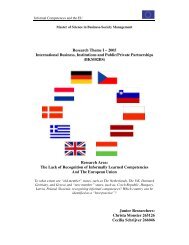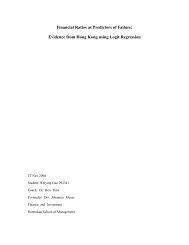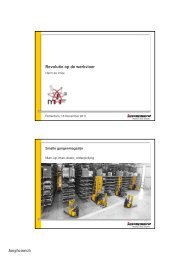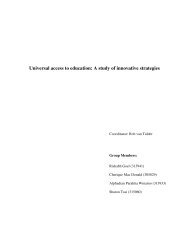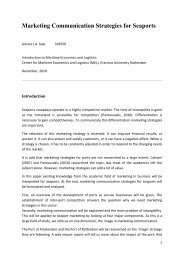here - ERIM - Erasmus Universiteit Rotterdam
here - ERIM - Erasmus Universiteit Rotterdam
here - ERIM - Erasmus Universiteit Rotterdam
You also want an ePaper? Increase the reach of your titles
YUMPU automatically turns print PDFs into web optimized ePapers that Google loves.
A validation Study of House of Quality key performance indicators<br />
sample visits the site less than once a month (56%) or once a month (24.1%). As showed in Figure 10,<br />
the main reason for members to visit the site is to gather information (87.1%).<br />
4.2.2 Factor analyse<br />
In our model quality (Q) measured by one item is the sum of an expectation rating (E) extracted from<br />
the corresponding perception rating (P). A gap-score is defined as Q = P – E. The computed gap-<br />
variables are used for further scale analysis. Further analysis of the gap scores will be discussed in<br />
section 4.3.<br />
After qualitative research in phase one, the explored items were structured into five dimensions<br />
(Table 2). To test the structure of the modified dimensions factor analysis was conducted. Factor<br />
analysis is a multivariate statistical technique which aim is to reduce a large number of variables to a<br />
smaller number of underlying dimensions, known as factors. T<strong>here</strong>fore factor analysis will try to<br />
explain a maximum amount of variance in our data by means of a small number of factors.<br />
Before conducting factor analysis, we should test if factor analysis is an appropriate method for<br />
detecting structures in our data. T<strong>here</strong>fore we will first inspect the correlation matrix, the Bartlett’s<br />
test of sphericity, the Kaiser-Meyer-Olkin (KMO) and the measure of sampling adequacy (MSA).<br />
When the results of the tests conclude that factor analysis is allowed, the items will be structured<br />
into factors.<br />
The Bartlett’s test of sphericity will test the inequality between the correlation matrix and the<br />
identity matrix. The test values detected a significant result (Chi 1164.774; p:0.00) from which we can<br />
conclude that t<strong>here</strong> are differences between the correlation matrix and the identity matrix. The<br />
second test, the Kaiser-Meyer-Olkin test, measures the sampling adequacy. A high value indicates<br />
sufficient intercorrelations between the variables which mean that the correlations between pairs of<br />
variables can be explained by other variables.. The test value in our analysis is 0.875. A value of >0.8<br />
is meritorious. The last test for sufficient intercorrelations is the Measure of Sampling Adequacy<br />
(MSA). Looking at the anti-image matrix in SPSS, low MSA values of




